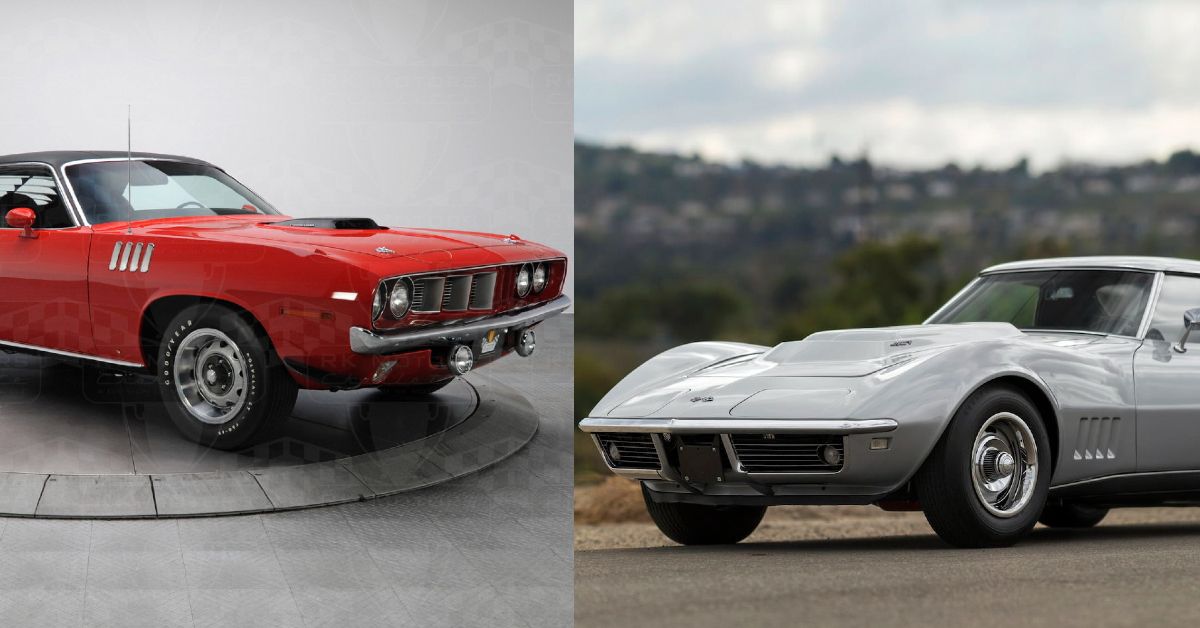The two-seater 1968 Chevrolet Corvette, designed as a genuine home-grown sports car to compete with European imports, may not suit the muscle car label for several American muscle car aficionados. To the entire world, however, the car's huge block V8 engine options and low price made it a prime example of an ideal muscle car.
At the height of the muscle car era, the Corvette C3 Stingray debuted in 1968, with an L88 big block engine variant meant specifically for racing. The 7.0-liter V8 has an estimated output of about 430 horsepower, while many believe that the production models have well over 540 horsepower when they left the factory. Other enhancements on the L88 included a heavy-duty 4-speed manual transmission, upgraded suspension and brakes, and the removal of the air conditioning, heating, and radio options.
The Plymouth Barracuda debuted a few weeks before the Ford Mustang in the year 1964. Notably, while the Mustang competitor boasted sporty style and low costs, it however spent the majority of its existence in the shadows of the far more successful Ford. Nonetheless, the iconic Hemi-powered 'Cuda was among the most sought muscle cars of the classic era.
The Hemi 'Cuda, which was released in 1970, had 7.0-lite V8 engine that produced 420 hp and could accelerate from rest to 60 mph in a mere 5.6 seconds. Also, its parts were designed with cartoonish colors and a 'shaker hood scoop' jutting through the hood to assist in pumping air into its engine.
Plymouth did not want to kill their iconic Hemi V8 to satisfy new pollution laws, hence, the model was canceled in 1971 just after 115 vehicles were sold. Of course, this Hemi 'Cuda is now an immensely collectable car, with the rarest being the convertible variants, and it commands huge amounts of money.
1968 Chevrolet Corvette L88 Vs 1971 Plymouth Hemi Cuda: Underneath Their Hoods
The 1968 Chevrolet Corvette L88, like any racing vehicle, has no choke, fan shroud, and in certain cases, the heating system. With its exhaust eliminated and operating on race gasoline, the L88 produced 600 horsepower, more than enough to emerge victorious at the 1967 12 Hours of Sebring. On the highway, the L88 can produce anything between 550 and 570 hp in factory trim.
The L88 was more than simply an engine improvement. A Muncie M22 or M20 hydramatic transmission, an F41 heavy-duty suspension with redesigned dampers and coil springs, power-assisted heavy-duty brakes, a G81 positraction rear axle, and a unique cowl induction hood were all required factory additions.
The stock A833 4-speed manual gearbox combined with a Hurst Pistol Grip shifter is one of several reasons why the Hemi Cuda is amazing. This option was available on only three vehicles. A vicious 7.0-liter Hemi 426 V8, which produces 425 horsepower and a 490 lb-ft of torque. It comes standard with the A33 Track Pak, which features a Dana sixty sure grip rear differential, a 3.54 final gear ratio, as well as a heavy-duty engine cooling system.
Their Race-Inspired Interior And Exterior Designs
The Corvette exterior and interior were extensively overhauled for the1968 year model. The automobile was still available as a convertible or coupe, however, the coupe was now a notchback with a near-vertical detachable rear window and detachable roof panels. Convertibles came standard with a soft foldable top, but a supplemental hardtop with a glass back window was available for an extra fee.
Hold down straps, as well as a set of vinyl covers use to keep the roof panels in place, were included along with coupes, as was a rear window stowage tray above the luggage space. The disguised headlamps on the durable new body moved into place using a vacuum-operated mechanism instead of electrically as on the previous generation, while the new concealable windshield wipers made use of a troublesome vacuum door.
The massive, partitioned front grille with the round headlights, pronounced rear fenders, and horizontal, tri-bar rear lights distinguish the 1970 Hemi Cuda. When compared to the second-generation Barracuda, the bumper is now merged into the body, and also the roof is slightly lower, blending with the car's relatively low and broader stance. All Hemi-equipped Cudas had the shaker bonnet option, as well as race-inspired hood pins. Other decorative options for the HEMI Cuda included a variety of decal kits and high-impact colors.
A minor makeover in 1971 included a redesigned grille and four headlights to the Cuda's front demeanor, while the back fascia got one-piece taillights. Plymouth also incorporated four gills to the front fenders of the muscle car. The rubber bumpers as well as shaker hood variants remained.
1968 Chevrolet Corvette L88 Vs 1971 Plymouth Hemi Cuda: Dazzling Performances
The L88's story begins with Zora Arkus introduction to Chevrolet. Duntov was the first to persuade Chevrolet to include a manual gearbox and a bigger engine in the Corvette, transforming the 1956 model into a true sports car. Duntov was then persuaded by Don Yenko and the Sunray DX Motorsports squad to compete and modify the Chevrolet into the L88. This vehicle had to be a normal factory option to be qualified for SCCA A-Production and also FIA GT competitions, therefore GM surreptitiously released it to the public.
Since its inception, the L88 Corvette has performed exceptionally, and now it holds NCRS Top Flight, performance verification, Bloomington Gold certification and Duntov Mark of excellence certifications, and has traveled to MCACN for the trifecta, receiving Concours gold and triple diamond awards.
The 1971 Plymouth Hemi Cuda is also a sports car that had very exceptional performances over time, and due to its iconic performances, it is set to becoming one of the most expensive muscle cars ever sold.


.jpg)
-2.jpg)
-2.jpg)
-3.jpg)
.jpg)
-2.jpg)